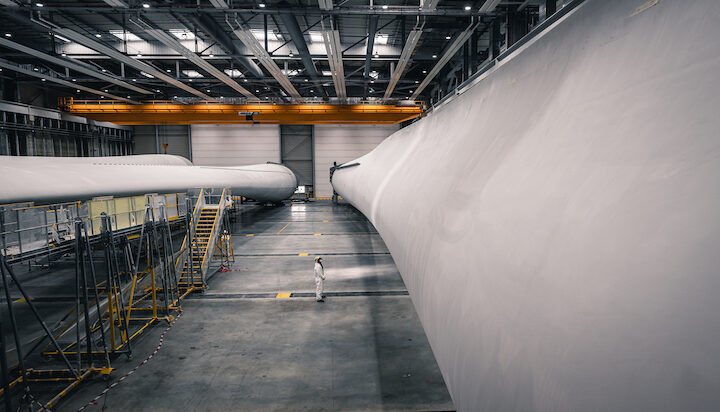
Clean Power
This Industrialized Offshore Floating Wind Turbine Foundation Demonstration Project Is A World’s First
ByJesper Berggreen
Published 1 day ago
The TetraSpar full-scale demonstration project is the world’s first industrialized offshore foundation manufacturing and deployment system for wind turbines. I saw it up close but didn’t have a clue of its significance at the time.
TetraSpar Demonstrator Project as I entered the Maersk Interceptor drilling rig
A couple of weeks ago I wrote a piece on my visit to a drilling rig that was being serviced at Grenaa port, Denmark. I noted a floating wind turbine next to the rig, and I was curious about where it was headed, and when. A couple of days ago I learned that it had headed out to sea with its course set to Stavanger, Norway.
A story in local news media and information on the website of the company behind the project, Stiesdal Offshore Technologies A/S, made its mission clear.
When I was standing on the helipad of the Maersk Interceptor drilling rig some 100+ meters (330 feet) above sea level looking straight over at the nacelle of the turbine, it was hard to make out its actual size. With one blade pointing straight up it was competing with the 200 meter (656 feet) high legs of the rig to be the tallest construction in the vicinity. Come to think of it, the highest point of land in Denmark is 173 meters (568 feet) above sea level!
Photos from the Tiesdal’s website brings things into perspective. This thing is huge! It will rise 166 meters (545 feet) above sea level when deployed with most of its foundation being submerged.

Photo credit: The TetraSpar Demonstrator Project ApS.
As you can see in the photos above, the foundation is fully modular, and can be assembled relatively easily at the port grounds. The mobile cranes give a good sense of the size. The keel is the triangle not painted yellow. And the wind turbine? From the website (with many more photos):
“a 3.6 MW wind turbine from Siemens Gamesa Renewable Energy will be mounted on the foundation at the quayside using a land-based crane. From there, the combined structure will be towed to the test site, moored to the seabed with three anchor lines and connected to the electrical grid.”
It can operate at sea depths from 100 to 1000+ meters (3,280+ feet), and the company is already working on foundations that will carry new generation wind turbines with a nameplate capacity of up to 15 MW. As for the location, this particular turbine will travel on its foundation some 360 nautical miles, 1 week of towing from where it was assembled:
“The combined structure will be towed to the test site in the northern part of the North Sea, moored to the seabed with three anchor lines and connected to the electrical grid. It will be located at the Marine Energy Test Centre (Metcentre) near Stavanger in Norway, approximately 10 km from shore at a water depth of 200 meters.”
There are other floating wind concepts being tested around the world, but the Danish model is designed to be cheap — and thus more competitive. To the local news TV2 Østjylland CEO of Stiesdal Offshore Technologies A/S, Peder Nickelsen states: “This is why we have created a concept where we manufacture all the parts at a factory, and assemble them at the port — without welding and making too complicated assemblies at the port.”

Photo credit: The TetraSpar Demonstrator Project ApS.

Photo credit: The TetraSpar Demonstrator Project ApS.
Jesper had his perspective on the world expanded vastly after having attended primary school in rural Africa in the early 1980s. And while educated a computer programmer and laboratory technician, working with computers and lab-robots at the institute of forensic medicine in Aarhus, Denmark, he never forgets what life is like having nothing. Thus it became obvious for him that technological advancement is necessary for the prosperity of all humankind, sharing this one vessel we call planet earth. However, technology has to be smart, clean, sustainable, widely accessible, and democratic in order to change the world for the better. Writing about clean energy, electric transportation, energy poverty, and related issues, he gets the message through to anyone who wants to know better. Jesper is founder of Lifelike.dk and a long-term investor in Tesla, Ørsted, and Vestas.
Copyright © 2021 CleanTechnica. The content produced by this site is for entertainment purposes only. Opinions and comments published on this site may not be sanctioned by and do not necessarily represent the views of CleanTechnica, its owners, sponsors, affiliates, or subsidiaries.
















/cloudfront-us-east-1.images.arcpublishing.com/tgam/46Z5S3MUQBAQNCEMQUDLLQLZJ4.JPG)
/cloudfront-us-east-1.images.arcpublishing.com/tgam/YWAZ6TR36RADBJD6DOGHQB4HTA.jpg)

/cloudfront-us-east-1.images.arcpublishing.com/tgam/3PFPE53WMZIYDMIQUKZEP47QTQ.jpg)
/cloudfront-us-east-1.images.arcpublishing.com/tgam/JJXTLFYWKZK4JC5KASLNSGNJRI.JPG)
/cloudfront-us-east-1.images.arcpublishing.com/tgam/KQBRJS5FKBP5DE73NMU6VXRWNU.jpg)
/cloudfront-us-east-1.images.arcpublishing.com/tgam/KKR4AVZWANAKTNWWYTTFOZR6AM.JPG)
/cloudfront-us-east-1.images.arcpublishing.com/tgam/HHM3MVTVGNLPJH7L5PO6O4MR6I.jpg)